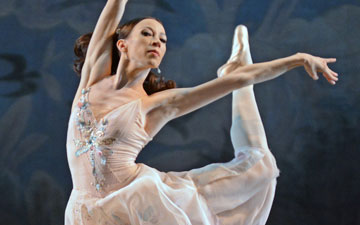
© Dave Morgan. (Click image for larger version)
Mariinsky Ballet
La Bayadere
★★★★✰
London, Royal Opera House
10 August 2017
Gallery of pictures by Dave Morgan
mariinsky.ru
www.roh.org.uk
From the moment Kimin Kim enters with a flourish as Solor in Act I of La Bayadère, we know we’re in for a treat. He’s a noble warrior, handsome and commanding. No wonder his beloved temple maiden, Nikiya, will risk all to be with him. Like Albrecht in Giselle, however, Solor turns out to be a despicable betrayer, abandoning his low-born love for an heiress.
As wronged Nikiya, Viktoria Tereshkina is so sensually beguiling that she inflames the lust of the ascetic High Brahmin of the temple to which she belongs. Soslan Kulaev, a very tall character dancer (the Don in Don Quixote), conveys the priest’s conflict compellingly, dominating the stage with his resentment at being rejected.

© Dave Morgan. (Click image for larger version)
Since Nikiya is so scantily clad, Tereshkina’s bare midriff provides the opportunity to see the strength of the dancer’s slender torso, the powerhouse of her supple limbs and spine. Watch her stay calm and still on pointe before unfurling a leg as high as she chooses; see how she curves into a backbend as an exotic entertainer at Solor’s engagement ceremonies. Then marvel at how she preserves the classical line of her arabesque as the Queen of the Shades in Act III.
The only drawback is that Tereshkina is an aristocrat of a dancer. She has been given leading roles in almost every first night performance (due to Oxana Skorik’s injury), as Kitri, Odette/Odile, Paquita and Nikiya. Although she is an exquisite technician, she doesn’t have a broad range as an actress. Her Nikiya is even more imperious than Nadezhda Batoeva’s Gamzatti, the Rajah’s spoilt dancer. As a result, Nikiya appears to come off best in their fight over who has the rightful claim to Solor.

© Dave Morgan. (Click image for larger version)
Batoeva proves how accomplished she is as a dancer in the Act II betrothal scene, but her effort is evident. She can’t yet connect the upper and lower halves of her body as seamlessly as Tereshkina does. Batoeva is, of course, out-jumped by virtuoso Kim, who floats through their Act II pas de deux. His solo variation (choreographed by Vakhtang Chabukiani ) includes the counter-clockwise manège of double assemblés en tournant with which Rudolf Nureyev first astounded the West in the 1960s. Kim executes eight in sequence, instead of the usual six.
He does look suitably downcast throughout the betrothal ceremony, from his grand entry atop a wooden elephant to his unease during Nikiya’s reproachful dance. She elects to die from a (rubber) snake’s bite, rejecting the antidote, because he turns away to remain with Gamzatti – so surely he shouldn’t return to mourn over her corpse: a wrong move, however regretful Solor might be.

© Dave Morgan. (Click image for larger version)
The Act II ceremony is a delight, the stage filled with performers of all kinds: ungainly extras, boisterous ‘Indian’ drummers, decorous fan-wavers, parrot-bearers, tutu-wearers with yet more bare midriffs, and impish children (no longer in black-face). Amazing how much space the cohorts of dancers cover in spite of the hordes behind them. Vasily Tkachenko is a streak of pure gold as the bounding Idol; Sofia Ivanova-Skoblikova charms as the Manu jug-balancer with two little girls. The demi-soloists in their classical ensembles are well-matched and far more orderly than their equivalents in the Paquita Grand Pas the night before.
The corps of 36 bayadères descend the double ramps magically in the Kingdom of the Shades, veiled arms resembling insects’ wings. The craggy setting of the Himalayas is austere, with no lilac blossom to sweeten Solor’s dream of redemption. This is very much Tereshkina’s domain, as she treats Kim’s eager Solor with the hauteur he deserves. Mariinsky Shades do not smile (unlike the Royal Ballet’s), no matter how cheerful Minkus’s music becomes. The three soloists are ethereal beings, silent and precise: Yana Selina, secure in the cabriole variation, is flanked by youngsters; Renata Shakirova, fleet and fast, and May Nagahisa, only 17, perfecting the slow pirouettes at the start of hers.

© Dave Morgan. (Click image for larger version)
This production of the 1877 ballet, revised during the Soviet era, ends with Solor reunited with Nikiya among the Shades. A final act to tidy up the simple plot, as in the Royal Ballet’s production by Natalia Makarova, isn’t really necessary. We can go home blessed, thankful that the Mariinsky Ballet can still lay claim to La Baydère and its Kingdom of the Shades as their calling card.
This has otherwise been a slightly disappointing season, without the champagne fizz of previous ones. (Remember the era of Altynai Asylmuratova and Farukh Ruzimatov?) We haven’t seen enough of the principals, particularly the men – apart from Xander Parish: those who appeared in Wayne McGregor’s Infra in the triple bill remained largely anonymous. We won’t be seeing the company for several years to come, alas. There will no visiting Russians in 2018, since the Royal Opera House is needed for rehearsals of The Ring cycle (why?), and then it’s the turn of Bolshoi – assuming, that is, that the Hochhausers gallantly continue their role as long-serving impresarios. Please do!

















You must be logged in to post a comment.